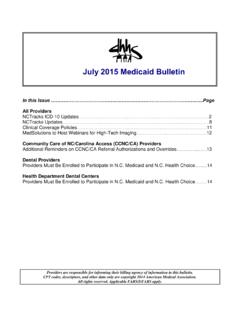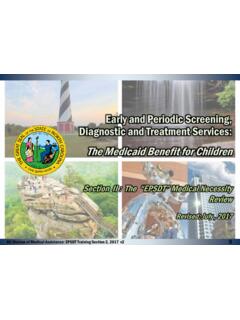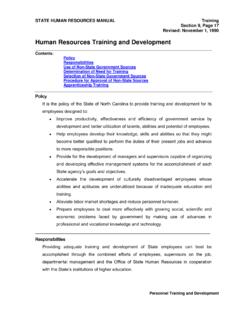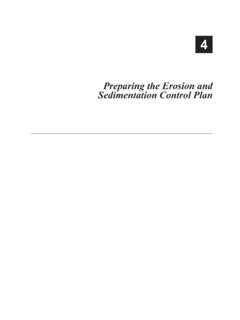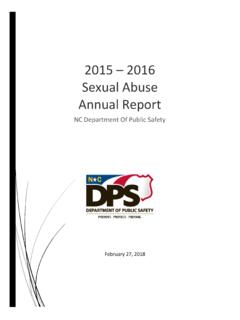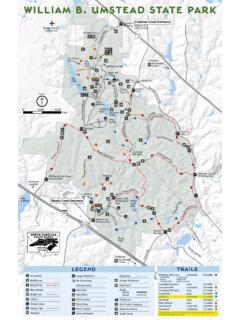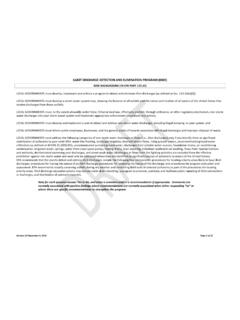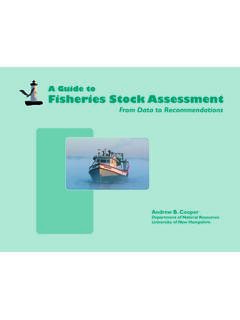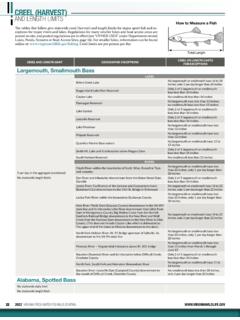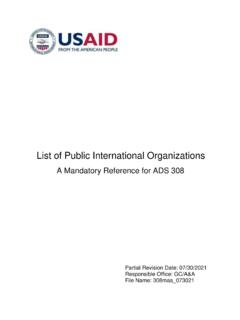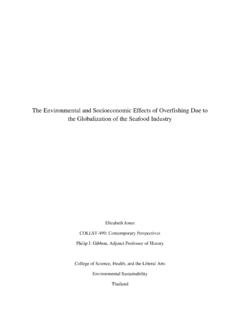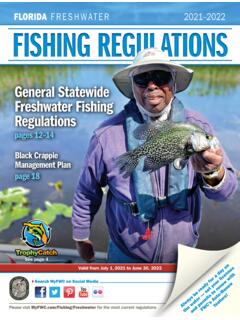Transcription of CAMA Handbook for Coastal Development
1 CAMA Handbook for Coastal Development April 2014 How to Use This Guide This Handbook is designed to help you understand what types of projects require CAMA Development permits, the Development regulations you will have to follow, and how following those rules helps protect the natural resources that draw people to North Carolina's Coastal counties in the first place. Although this guide discusses regulations, it is not an official statement of North Carolina Coastal Development regulations and may not be relied on in lieu of those regulations in undertaking Coastal Development . All Coastal Development projects subject to CAMA must be approved by the Division of Coastal Management. A list of Coastal Management offices is in Section 9 of this guide. An unofficial version of the Development regulations may be found on the DCM website. You may obtain an official copy of the regulations from the Office of Administrative Hearings at 919-733-2691.
2 Introduction The North Carolina coast may seem indestructible, but it's not. Left unmanaged, Development around our state's sounds, rivers and beaches can destroy the very ecological, aesthetic and economic features that draw people to our shore. In 1972, Congress passed the Coastal Zone Management Act, which encouraged states to keep our coasts healthy by establishing programs to manage, protect and promote our country's fragile Coastal resources. Two years later, the North Carolina General Assembly passed the landmark Coastal Area Management Act, known as CAMA. CAMA established the Coastal Resources commission , required local land use planning in 20 Coastal counties and provided for a program for regulating Development . The North Carolina Coastal Management Program was federally approved in 1978. As a part of this program, the Coastal Resources commission (CRC) designated "Areas of Environmental Concern" within the 20 Coastal counties and set rules for managing Development within these areas.
3 An Area of Environmental Concern, or AEC, is an area of natural importance: It may be easily destroyed by erosion or flooding; or it may have environmental, social, economic or aesthetic values that make it valuable to our state. The CRC's rules are administered by the North Carolina Division of Coastal Management, a part of the state Department of Environment and Natural Resources. About This Guide This Handbook is a guide to the permit program set up by the CRC. It is designed for those who want to develop or build in the 20 Coastal North Carolina counties. Because rules change, regulations are often more complicated than outlined here and every project is different, you should always contact the Division of Coastal Management before you begin Development on or near the coast. Living and building in Coastal North Carolina without destroying the natural systems around us or putting our lives in danger is a challenge.
4 By following the standards set by the Coastal Area Management Act and the CRC, you can protect our Coastal resources as well as your own Development project. Section 1: Will Your Project Require a CAMA Permit? You must obtain a Coastal Area Management Act, or CAMA, permit for your project if it meets all of the following conditions: It is in one of the 20 counties covered by CAMA. It is considered " Development " under CAMA. It is in, or it affects, an Area of Environmental Concern (AEC) established by the Coastal Resources commission (CRC). It doesn't qualify for an exemption. What's the CRC? The Coastal Resources commission is a 15-member citizen board appointed by the Governor to establish rules and policies for Development within the 20 Coastal counties. The CRC receives guidance from a 45-member Coastal Resources Advisory Council, or CRAC. CRAC members represent local governments, state agencies and other areas of technical expertise.
5 Members of the CRAC are responsible for keeping their appointing bodies up-to-date on CRC activities. What are the 20 Coastal counties covered by CAMA? If your project is in one of the following 20 counties and is located along the state's rivers, sounds or the Atlantic Ocean, you may need a permit: Beaufort Bertie Brunswick Camden Carteret Chowan Craven Currituck Dare Gates Hertford Hyde New Hanover Onslow Pamlico Pasquotank Pender Perquimans Tyrrell Washington Does my project qualify as Development ? The Coastal Area Management Act defines Development as: "any activity in a duly designated area of environmental concern .. involving, requiring or consisting of the construction or enlargement of a structure; excavation; dredging; filling; dumping; removal of clay, silt, sand, gravel or minerals; bulkheading; driving of pilings; clearing or alteration of land as an adjunct of construction; alteration or removal of sand dunes; alteration of the shore, bank or bottom of the Atlantic Ocean or any sound, bay, river, creek, stream, lake or canal; or placement of a floating structure in an Area of Environmental Concern identified in 113A-113(b)(2) or (b)(5)" {NCGS 113A-103(5)(a)}.
6 Is my project in an Area of Environmental Concern? You're probably in an AEC if your project is: in, or on the shore of, navigable waters within the 20 CAMA counties; on a marsh or wetland; within 75 feet of the normal high water line along an estuarine shoreline; near the ocean beach; within an ocean high hazard flood area; near an inlet; within 30 feet of the normal high water level of areas designated as inland fishing waters by the Marine fisheries commission and the Wildlife Resources commission ; near a public water supply; within 575 feet of Outstanding Resource Waters defined by the Environmental Management commission . Areas of Environmental Concern are described in detail in the next section of this manual. If you already know that your project is in an AEC and you want to go straight to the application information, turn to Section 5.
7 When is my project exempt from the CAMA permit requirements? Section 113A-103(5)(b) of CAMA exempts the following activities from the definition of Development : road maintenance within a public right-of-way; utility maintenance on projects that already have CAMA permits; energy facilities covered by other laws or Utilities commission rules; agricultural or forestry production that doesn't involve the excavation or filling of estuarine or navigable waters or Coastal wetlands (Note: these activities are not exempt from permitting requirements under the state's Dredge and Fill Law.); agricultural or forestry ditches less than 6 feet wide and 4 feet deep; emergency maintenance and repairs when life and property are in danger; the construction of an accessory building usually found with an existing structure, if no filling of estuarine or navigable waters or Coastal wetlands is involved.
8 In addition, CAMA allows the CRC to exempt some types of minor maintenance and improvements. These types of projects, outlined in Section 6, are those with successful track records in protecting the resources around them. In all cases, you should check with the Division of Coastal Management before you begin work to make sure that your project qualifies for an exemption. Section 2: Areas of Environmental Concern Areas of Environmental Concern (AECs) are the foundation of the Coastal Resources commission 's permitting program for Coastal Development . An AEC is an area of natural importance: it may be easily destroyed by erosion or flooding; or it may have environmental, social, economic or aesthetic values that make it valuable to our state. The Coastal Resources commission designates areas as AECs to protect them from uncontrolled Development , which may cause irreversible damage to property, public health or the environment, thereby diminishing their value to the entire state.
9 The CRC has set up four categories of AECs: A. The Estuarine and Ocean System B. The Ocean Hazard System C. Public Water Supplies D. Natural and Cultural Resource Areas AECs cover almost all Coastal waters and about 3 percent of the land in the 20 Coastal counties. The following descriptions will help you determine if your project is in an AEC and will help you understand the importance of these natural systems. A. The Estuarine and Ocean System AEC The estuarine and ocean system is the coast's broad network of brackish sounds, marshes and surrounding shores. Normally found where rivers and streams meet the ocean, an estuary is a unique and important part of Coastal life a transitional area where fresh and salt water mix. From broad, shallow sounds like the Albemarle and Pamlico, to narrow bodies of water such as Core and Masonboro sounds, North Carolina has million acres of estuarine waters.
10 Cradled behind the state's long string of barrier islands, these shallow sounds, rivers and creeks make up one of the largest estuarine systems in the United States. Permits may be required for Development in four components of this system (see Figure ). 1. Public Trust Areas are the Coastal waters and submerged lands that every North Carolinian has the right to use for activities such as boating, swimming or fishing. These areas often overlap with estuarine waters, but they also include many inland fishing waters. The following lands and waters are considered public trust areas: all waters of the Atlantic Ocean and the lands underneath, from the normal high water mark on shore to the state's official boundary three miles offshore; all navigable natural water bodies and the lands underneath, to the normal high water mark on shore (a body of water is considered navigable if you can float a canoe in it).

